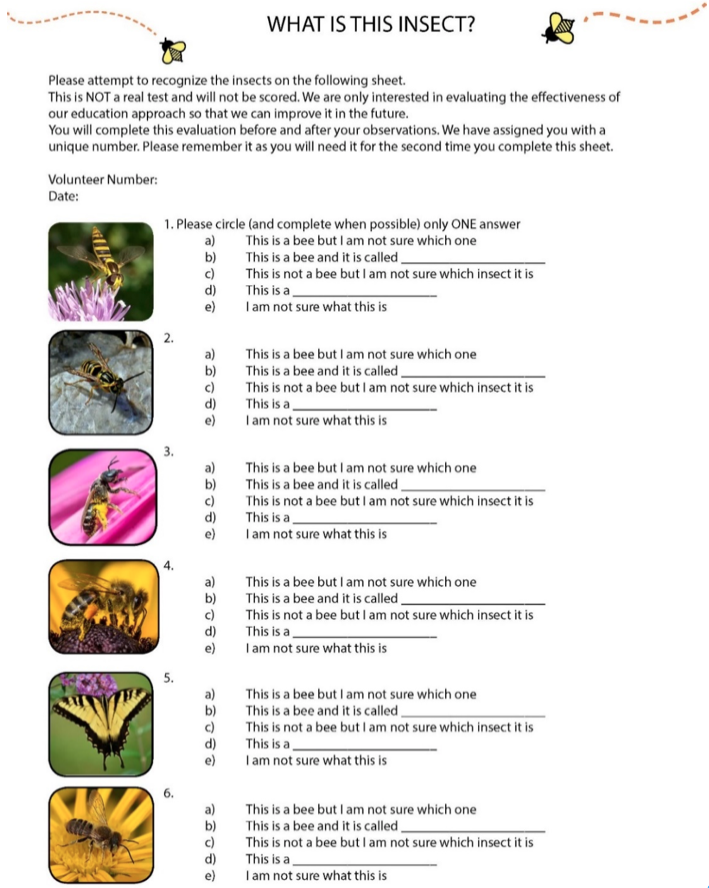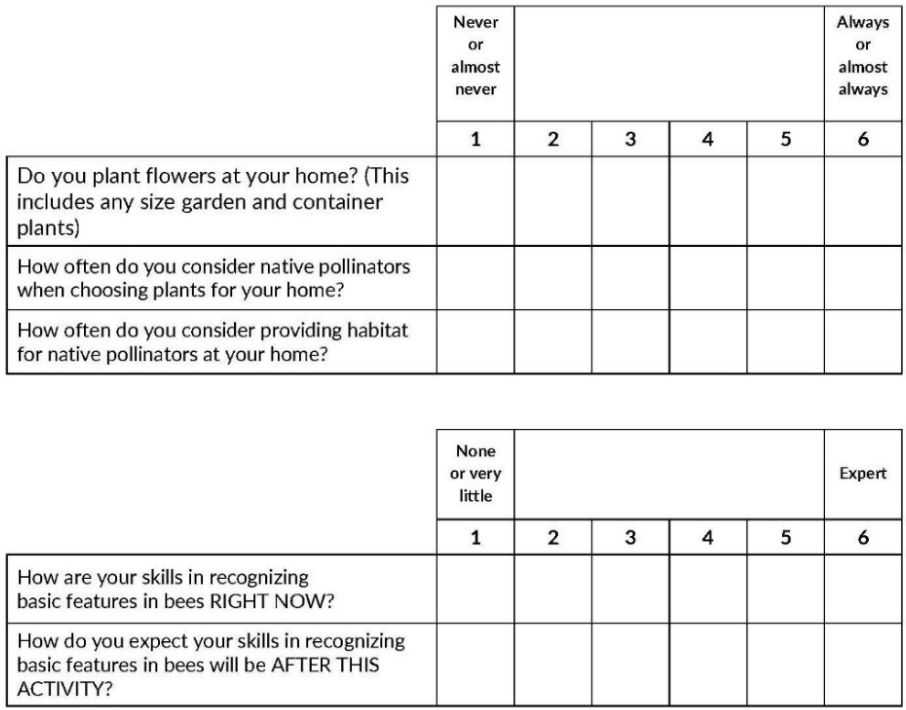 |
October 2019
|
October 2019 // Volume 57 // Number 5 // Tools of the Trade // v57-5tt5
Experience Bees: Community Outreach Tool for Bee Conservation Efforts
Abstract
Despite the importance of bees, there is a gap in the public's understanding of them. To help address this gap, we developed the outreach tool Experience Bees, a series of simple learning and hands-on activities to teach community members about bees and their importance in our landscapes. Program evaluation showed that participants learned about bees and were more willing to consider bees when planting their own gardens, demonstrating that a suite of simple activities can have a positive impact on people's knowledge of bees and their importance. We encourage readers to use our tool and replicate our methods or to design and implement similar projects to engage their audiences in pollinator conservation.
Introduction
Insect pollinators are an essential part of our food production system. In recent years, insect pollination services were estimated to be worth $15 billion in the United States (Calderone, 2012) and $361 billion worldwide (Lautenbach, Seppelt, Liebscher, & Dormann, 2012). Of all types of pollinators, honey bees and native bees have the greatest positive impact on agriculture (Kleijn et al., 2015; Klein, Cabirol, Devaud, Barron, & Lihoreau, 2017).
Despite the importance of bees, there is a gap in the public's understanding of these insects (Ingram, Nabhan, & Buchmann, 1996; Silva & Minor, 2017). Previous studies have demonstrated that the general public knows little about bees, and in some cases, that people are even fearful of them (Harris & Braman, 2016; Silva & Minor, 2017). Authors of these studies call for education programs that incorporate either direct contact with bees or gardening activities, with the intent being to aid in greater conservation efforts and educate the public about pollinator protection.
As human populations increase and urbanization expands, habitat suitable for bees declines, resulting in serious threats to bee populations (Burkle, Marlin, & Knight, 2013; Calderone, 2012). To mitigate this trend, it is imperative that we continue efforts to increase public awareness of the importance of bees and bee habitat and encourage communities to protect and conserve bees.
To aid in these efforts, we developed a community outreach tool called Experience Bees that we have employed at our local pollinator garden. The objectives are to help community members gain a greater understanding of the importance of bees through a series of simple hands-on activities, to inspire participants to learn more about bees, and to encourage them to create pollinator habitat in their own landscapes.
Description of Tool and Activities
Experience Bees is a series of activities that can be replicated easily. We designed the activities to incorporate an experiential approach that has been shown to be effective in teaching scientific information (Beard, 2010). The tool involves six activities: a preactivity knowledge evaluation, a preactivity perception survey, a presentation on bees, a bee observation period, a postactivity knowledge evaluation, and a postactivity perception survey. For the development of the surveys, we collaborated with an expert impact evaluation specialist at the NSF Center for Integrated Pest Management and followed guidelines as outlined by Bamberger, Rugh, Church, and Fort (2004).
Preactivity Knowledge Evaluation
We designed a knowledge evaluation instrument—one sheet with 23 photos of pollinating insects and multiple-choice answers (Figure 1)—that we use to evaluate how many bees participants can identify prior to taking part in Experience Bees. We incorporated only bee species found in the local area and included other insects such as flies and butterflies that participants could easily identify. Participants are asked to complete the evaluation sheet when they arrive at the program venue.
Figure 1.
First Page of Preactivity Knowledge Evaluation Used to Evaluate Participants' Prior Knowledge of Bees

Preactivity Perception Survey
We designed a five-question survey to evaluate participants' perceptions of the importance of bees and of incorporating bee habitat in their landscapes (Figure 2).
Figure 2.
Preactivity Perception Survey Used to Evaluate Participants' Existing Perceptions Related to Importance of Pollinators

Bee Presentation
We developed a 20-min slideshow addressing the importance of bees, bee identification, and other topics related to pollination and bee natural history.
Bee Observations
We developed an insect checklist comprising the same pictures we used in the preactivity knowledge evaluation (Figure 3). Participants are assigned a flowering plant and asked to observe it for 10 min and record on the checklist which bees they see during that period. Each participant repeats this 10-min observation three times.
Figure 3.
Pollinator Checklist Participants Use to Record Types and Numbers of Insects Observed in Garden During Observation Periods

Postactivity Knowledge Evaluation
Participants complete an evaluation after the presentation and observations, using the same evaluation form as that used for the preactivity knowledge evaluation (see Figure 1).
Postactivity Perception Survey
We designed a five-question survey to evaluate whether participants' perceptions regarding the importance of bees and of providing bee habitat differed after the activities (Figure 4).
Figure 4.
Postactivity Perception Survey Used to Evaluate Participants' Intention Change Regarding Importance of Pollinators

Evaluation of Experience Bees
To evaluate the outreach tool, we compared participants' knowledge of bees and perceptions of the importance of bees and bee habitat from before and after the activities (Bhattacharyya, Acharya, & Chakraborty, 2017). We were thus able to address the following questions, through identifying changes in participants' answers from before to after the experience:
- Was the project successful in teaching participants the basic aspects of bee ecology? (That is, did they recognize more bees on the knowledge evaluation sheet after the activities?)
- Was the project successful in increasing participants' awareness on the importance of bees? (That is, was their increased awareness reflected in their survey responses after the activities?)
- Did participants' perceptions of the importance of adding bee habitat in their own landscapes change from before to after the activities?
Method
We carried out seven events at our pollinator garden in Raleigh, North Carolina, during the spring and summer of 2017. There were 47 participants, who ranged in age from 7 to over 65 and came from a variety of backgrounds.
Upon arrival, each participant was assigned a number and was presented with the preactivity knowledge evaluation and the preactivity perception survey (see Figures 1 and 2). Following the presentation on bees, participants were asked to perform three 10-min observations in the garden and record the numbers and types of bees they observed using the checklist provided (see Figure 3). Local bee experts were on site to aid with insect identification and answer questions during the observations. After the third observation period, we gave participants the postactivity knowledge evaluation and the postactivity perception survey (see Figures 1 and 4).
Results
The project was successful in teaching participants basic bee identification skills (Figure 5) and the importance of bees (Figure 6). The knowledge evaluations were scored according to the number of bees participants were able to identify correctly. Of 47 participants, 45 (96%) scored higher on the postactivity knowledge evaluation. More importantly, results of the postactivity perception survey indicate that participants also were more willing to plant additional bee-friendly habitat in their home landscapes.
Figure 5.
Scores of 47 Participants on Knowledge Evaluations Completed Before Program Participation and After Program Participation

Figure 6.
Mean Responses Indicating Participants' Intention to Change

Conclusion
Our results are in accordance with other studies demonstrating that a suite of simple activities can have a positive impact on people's perception of bees as well as on the belief that we need to protect them. We encourage readers to use our tool and replicate our methods (readers can contact author Marisol Mata to request materials) or to design and implement similar projects as they have the potential to successfully convey the importance of bees to the general public and empower community members to participate in pollinator conservation efforts. Together we have the potential to produce a ripple effect that can extend throughout larger regions, with a positive and ever-increasing impact on education of our community members and conservation and protection of pollinators.
Acknowledgments
We wish to acknowledge funding sources for our work provided in part by Syngenta, the North Carolina State University Center for Turfgrass Environmental Research and Education, and North Carolina State University's Sustainability Fund. We also wish to acknowledge the staff at the JC Raulston Arboretum for all their support as well as the collaboration of expert entomologists Elsa Youngsteadt, Kim Huntzinger, Heather Moylett, Jessica Kettenbach, Morgan Scalici, and Alison Fowler. We appreciate the help of Anne Spafford in the design and installation of the pollinator gardens. We also wish to thank Damon Hall for his helpful comments and edits. Lastly, we would like to thank all our volunteers for their passion, curiosity, and bee-positive attitude.
References
Bamberger, M., Rugh, J., Church, M., & Fort, L. (2004). Shoestring evaluation: Designing impact evaluations under budget, time and data constraints. American Journal of Evaluation, 25(1), 5–37. Retrieved from https://doi.org/10.1177/109821400402500102
Beard, C. (2010). The experiential learning toolkit: Blending practice with concepts. London, UK: Kogan Page Publishers.
Bhattacharyya, M., Acharya, S. K., & Chakraborty, S. K. (2017). Pollinators unknown: People's perception of native bees in an agrarian district of West Bengal, India, and its implication in conservation. Tropical Conservation Science, 10. Retrieved from https://doi.org/10.1177/1940082917725440
Burkle, L. A., Marlin, J. C., & Knight, T. M. (2013). Plant-pollinator interactions over 120 years: Loss of species, co-occurrence, and function. Science, 339(6127), 1611–1615. Retrieved from https://doi.org/10.1126/science.1232728
Calderone, N. W. (2012). Insect pollinated crops, insect pollinators and US agriculture: Trend analysis of aggregate data for the period 1992–2009. PLOS ONE, 7(5), e37235. Retrieved from https://doi.org/10.1371/journal.pone.0037235
Harris, B. A., & Braman, S. K. (2016). Opportunity to improve public perceptions of arthropods and arthropod-related benefits. Journal of Extension, 54(6), Article 6RIB7. Available at: https://www.joe.org/joe/2016december/rb7.php
Ingram, M., Nabhan, G., & Buchmann, S. L. (1996). Our forgotten pollinators: Protecting the birds and bees. Global Pesticide Campaigner, 6(4), 1–12. Retrieved from http://www.agriculturedefensecoalition.org/sites/default/files/pdfs/7Q_1996_Honey_Bees_and_Pollinators_December_December_4_1996_Pesticides_Insecticides_Herbicides_PANNA.pdf
Kleijn, D., Winfree, R., Bartomeus, I., Carvalheiro, L. G., Henry, M., Isaacs, R., . . . & Ricketts, T. H. (2015). Delivery of crop pollination services is an insufficient argument for wild pollinator conservation. Nature Communications, 6, 7414. Retrieved from https://doi.org/10.1038/ncomms8414
Klein, S., Cabirol, A., Devaud, J. M., Barron, A. B., & Lihoreau, M. (2017). Why bees are so vulnerable to environmental stressors. Trends in Ecology & Evolution, 32(4), 268–278. Retrieved from https://doi.org/10.1016/j.tree.2016.12.009
Lautenbach, S., Seppelt, R., Liebscher, J., & Dormann, C. F. (2012). Spatial and temporal trends of global pollination benefit. PLOS ONE, 7(4), e35954. Retrieved from https://doi.org/10.1371/journal.pone.0035954
Silva, A., & Minor, E. S. (2017). Adolescents' experience and knowledge of, and attitudes toward, bees: Implications and recommendations for conservation. Anthrozoös, 30(1), 19–32. Retrieved from https://doi.org/10.1080/08927936.2017.1270587




